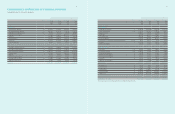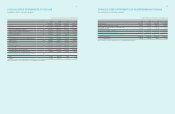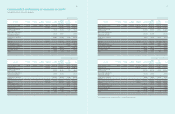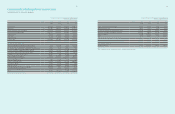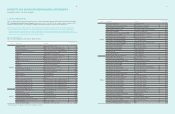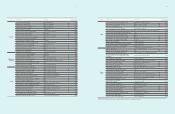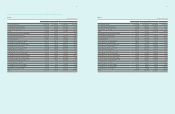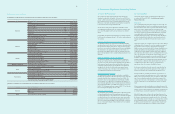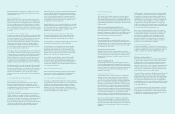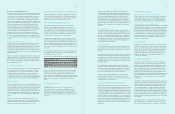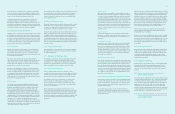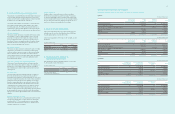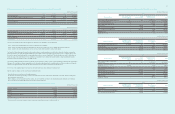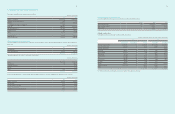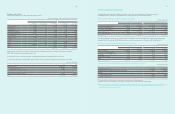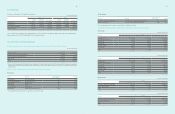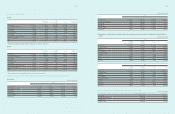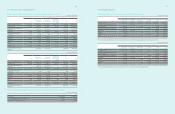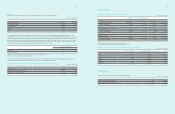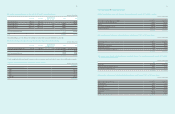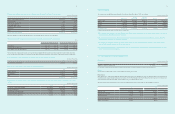Samsung 2011 Annual Report Download - page 29
Download and view the complete annual report
Please find page 29 of the 2011 Samsung annual report below. You can navigate through the pages in the report by either clicking on the pages listed below, or by using the keyword search tool below to find specific information within the annual report.
52
53
amount, which is also referred to as the ‘corridor limit’, is the greater of
ten per cent of the present value of the defined benefit obligation at the
end of the previous reporting period (before deducting plan assets) and
ten per cent of the fair value of any plan assets at that date.
For defined contribution plans, the Company pays contributions on
a mandatory, contractual or voluntary basis. The Company has no
further payment obligations once the contributions have been paid. The
contributions are recognized as employee benefit expense when they are
due. Prepaid contributions are recognized as an asset to the extent that a
cash refund or a reduction in the future payments is available.
2.16 Financial Guarantee Contract
Financial guarantee contracts are contracts that require the issuer to make
specified payments to reimburse the holder for a loss it incurs because a
specified debtor fails to make payments when due, Financial guarantees
are initially recognized in the financial statements at fair value on the date
the guarantee was given. If the amount measured in subsequent periods
exceeds the unamortized balance of the amount initially recognized, the
excess should be classified as other financial liability.
2.17 Provisions
Where there are a number of similar obligations, the likelihood that an
outflow will be required in settlement is determined by considering the
class of obligations as a whole. A provision is recognized even if the
likelihood of an outflow with respect to any one item included in the same
class of obligations may be small.
Provisions are measured at the present value of the expenditures
expected to be required to settle the obligation using a pre-tax rate that
reflects current market assessments of the time value of money and
the risks specific to the obligation. The increase in the provision due to
passage of time is recognized as interest expense.
When there is a probability that an outflow of economic benefits will
occur due to a present obligation resulting from a past event, and whose
amount is reasonably estimable, a corresponding amount of provision
is recognized in the financial statements. However, when such outflow
is dependent upon a future event, is not certain to occur, or cannot be
reliably estimated, a disclosure regarding the contingent liability is made
in the notes to the financial statements.
2.18 Leases
The Company leases certain property, plant and equipment. Lease of
property, plant and equipment where the Company has substantially
all the risks and rewards of ownership are classified as finance leases.
Finance leases are capitalized at the lease’s commencement at the
lower of the fair value of the leased property and the present value of
the minimum lease payments. Each lease payment is allocated between
the liability and finance charges so as to achieve a constant rate on the
outstanding balance. The corresponding rental obligations, net of finance
charges, are included in other long-term payables. The interest element
of the finance cost is charged to the statement of income over the
lease period so as to produce a constant periodic rate of interest on the
remaining balance of the liability for each period. The property, plant and
equipment acquired under finance leases is depreciated over the shorter
of the useful life of the asset and the lease term.
Leases in which a significant portion of the risks and rewards of ownership
are retained by the lessor are classified as operating leases. Payments
made under operating leases (net of any incentives received from the
lessor) are charged to the statement of income on a straight-line basis
over the period of the lease.
2.19 Derivative Instruments
All derivative instruments are accounted for at fair value with the resulting
valuation gain or loss recorded as an asset or liability. If the derivative
instrument is not designated as a hedging instrument, the gain or loss is
recognized in the statement of income in the period of change.
Fair value hedge accounting is applied to a derivative instrument with the
purpose of hedging the exposure to changes in the fair value of an asset
or a liability or a firm commitment (hedged item) that is attributable to a
particular risk. Hedge accounting is applied when the derivative instrument
is designated as a hedging instrument and the hedge accounting criteria
have been met. The gain or loss, both on the hedging derivative instrument
and on the hedged item attributable to the hedged risk, is reflected in the
statement of income.
2.20 Dividend Distribution
Dividend distribution to SEC’s shareholders is recognized as a liability in
the Company’s financial statements in the period in which the dividends
are declared and approved.
2.21 Share-based Compensation
The Company uses the fair-value method in determining compensation
costs of stock options granted to its employees and directors. The
compensation cost is estimated using the Black-Scholes option-pricing
model and is accrued and charged to expense over the vesting period,
with a corresponding increase in a separate component of equity.
2.22 Revenue Recognition
Revenue comprises the fair value of the consideration received or
receivable for the sale of goods and services in the ordinary course of the
Company’s activities. Revenue is shown net of value-added tax, returns,
rebates and discounts and after eliminating sales within the Company.
The Company recognizes revenue when specific recognition criteria
have been met for each of the Company’s activities as described
below. The Company bases its estimates on historical results, taking
into consideration the type of customer, the type of transaction and the
specifics of each arrangement.
Where multiple-element arrangements exist, the fair values of each
element are determined based on the current market price of each of the
elements when sold separately. When the fair values of each element are
indeterminable, the fair values of deliverables which have already been
provided are calculated in such way that the fair values of elements, which
are yet to be provided, are subtracted from total contract value of the
arrangement.
A) Sales of goods
Sales of products and merchandise are recognized upon delivery when
the significant risks and rewards of ownership of goods have transferred
to the buyer, continuing managerial involvement usually associated with
ownership and effective control have ceased, the amount of revenue can
be measured reliably, it is probable that the economic benefits associated
with the transaction will flow to the Company and the costs incurred or
to be incurred in respect of the transaction can be measured reliably. The
Company records reductions to revenue for special pricing arrangements,
price protection and other volume based discounts. If product sales are
subject to customer acceptance, revenue is not recognized until customer
acceptance occurs.
B) Sales of services
Revenues from rendering services are generally recognized using the
percentage-of-completion method, based on the percentage of costs to
date compared to the total estimated costs, contractual milestones or
performance.
C) Other sources of revenue
Interest income is recognized using the effective interest method. When
a loan and receivable is impaired, the Company reduces the carrying
amount to its recoverable amount, being the estimated future cash flow
discounted at the original effective interest rate of the instrument, and
continues unwinding the discount as interest income. Royalty income is
recognized on an accruals basis in accordance with the substance of the
relevant agreements. Dividend income is recognized when the right to
receive payment is established.
2.23 Government Grants
Grants from the government are recognized at their fair value where there
is a reasonable assurance that the grant will be received and the Company
will comply with the conditions attached. Government grants relating to
income are deferred and recognized in the statement of income over the
period necessary to match them with the income that they are intended to
compensate. Government grants relating to property, plant and equipment
are included in non-current liabilities as deferred government grants and
are credited to the statement of income on a straight-line basis over the
expected lives of the related assets.
2.24 Income Tax Expense and Deferred Taxes
The tax expense for the period comprises current and deferred tax. Tax is
recognized in the statement of income, except to the extent that it relates
to items recognized in other comprehensive income or directly in equity.
In this case the tax is also recognized in other comprehensive income or
directly in equity, respectively.
The current income tax charge is calculated on the basis of the tax
laws enacted or substantively enacted at the balance sheet date in the
countries where the company’s subsidiaries and associates operate and
generate taxable income.
Deferred income tax is recognized, using the liability method, on temporary
differences arising between the tax bases of assets and liabilities and their
carrying amounts in the consolidated financial statements. However, the
deferred income tax is not accounted for if it arises from initial recognition
of an asset or liability in a transaction other than a business combination
that at the time of the transaction affects neither accounting nor taxable
profit or loss. Deferred income tax is determined using tax rates (and laws)
that have been enacted or substantively enacted by the balance sheet
date and are expected to apply when the related deferred income tax
asset is realized or the deferred income tax liability is settled.
Deferred income tax assets are recognized only to the extent that it is
probable that future taxable profit will be available against which the
temporary differences can be utilized.
Deferred income tax assets and liabilities are offset when there is a legally
enforceable right to offset current tax assets against current tax liabilities
and when the deferred income taxes assets and liabilities relate to income
taxes levied by the same taxation authority on either the taxable entity or
different taxable entities where there is an intention to settle the balances
on a net basis.
2.25 Earnings Per Share
Basic earnings per share is calculated by dividing net profit for the period
available to common shareholders by the weighted-average number of
common shares outstanding during the year. Diluted earnings per share
is calculated using the weighted-average number of common shares
outstanding adjusted to include the potentially dilutive effect of common
equivalent shares outstanding.
2.26 Segment Reporting
Operating segments are reported in a manner consistent with the internal
reporting provided to the chief operating decision-maker. The chief
operating decision-maker is responsible for making strategic decisions
on resource allocation and performance assessment of the operating
segments.
2.27 Convenience Translation into United
States Dollar Amounts
The Company operates primarily in Korean Won and its official accounting
records are maintained in Korean Won. The U.S. dollar amounts provided
in the financial statements represent supplementary information solely
for the convenience of the reader. All Won amounts are expressed in U.S.
dollars at the rate of ₩1,153.30 to US $1, the exchange rate in effect
on December 31, 2011. Such presentation is not in accordance with
generally accepted accounting principles, and should not be construed as
a representation that the Won amounts shown could be readily converted,
realized or settled in U.S. dollars at this or at any other rate.
2.28 These Consolidated Financial Statements
Were Approved by The Board of Directors
on January 27, 2012.


